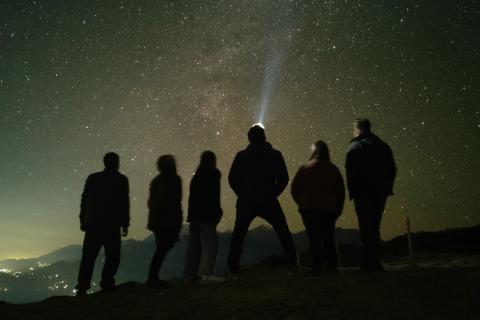
The news has had some good reminders of our ultimate human destiny this week, the Church turning our gaze to the remarkable holiness of some otherwise rather ordinary people: the Church in France, for instance, has opened the cause for canonization of an eighteenth-century married couple, Claude and Marguerite de La Garaye, whom Pope Saint John Paul II called “charitable spouses” and who gave up a rich and noble life to care for the poor; and Pope Francis announced that beginning next year, every Feast of the Dedication of Saint John Lateran (observed on November 9th), would be reserved for the veneration of any local Saints, Blesseds, Venerables, or Servants of God.
The witness of the saints is worth holding before our minds for any number of reasons. They remind us of the closeness to Christ for which we’re made; they intercede for us; they give us examples to imitate; and they shed light on astonishingly diverse expressions of Christian holiness. But another way they aid us is perhaps more subtle: they also give us good cause to maintain belief in a Church that often seems so obviously imperfect, otherwise.
Indeed, it doesn’t take much to notice that the Church suffers from a lot of the same wounds that every other human group does: you’ll find traces of the same corruption, the same hypocrisy, the same human pride and ambition. Your typical Christian is often not all that impressive, either. He or she has virtues and gifts that are frequently noteworthy, of course, but he or she is also usually embroiled in the same messy struggle with vice and temptation and weakness as everybody else. So why should we put the faith in the Church that we still do? Why should we think her worthy of our confidence and allegiance as an institution that can really transform our lives? How is she not just one more ideological group among others, making promises that may or may not be kept?
The great signs of the Church’s potency are the saints. They’re unique in that no other group of people on earth has figures like them, who manifest the big, extraordinary lives that they do. The heroic virtue combined with the spiritual power and wisdom alongside the miracles that occur by way of their presence and prayer … such people won’t be found anywhere else. Other faith traditions have their spiritual sages and wise guides, sure, but they don’t measure up to what the saints are. And that’s because none of those institutions or traditions measure up to what the Church is, either, and what the saints evidence she is: not just one more ideological group among others, but a supernatural society truly breaking into history.
This truth is perhaps even more piercing in the closeness of some of these holy men and women to us. Many people have met, or know people who have met, Pope Saint John Paul II, for instance; or there are servants of God like Michelle Duppong or, even more recently, Gertrude Barber, whose cause was just opened out of Erie, Pennsylvania, who lived and worked and prayed in exactly the sort of circumstances many of us do. Such individuals are witnesses not to being especially remarkable people on their own steam. Rather, each of them was quite commonplace, human just like all of us. They just happened to avail themselves most profoundly of the grace of God. They happened to give themselves most deeply to a life lived in and for the Church.
Leon Bloy once wrote, “The only real sadness, the only real failure, the only great tragedy in life, is not to become a saint.” The Church provides everything needed to avoid that tragedy – as all these holy men and women of God confirm, she is worthy of our trust, and worthy of our choice to entrust ourselves to her. The same graces all of them gained access to through her are ours to possess, too. It’s just for us to choose to open ourselves to them.
It’s official: Blessed Carlo Acutis will be canonized during the Jubilee of Teenagers (April 25-27, 2025) and Blessed Pier Giorgio Frassati will be canonized during the Jubilee of Youth (July 28-August 3, 2025).
In the 1960s, Latin America was virtually exclusively Catholic. Today, it’s over 20% Protestant (with Protestants outnumbering Catholics in some countries). What’s behind this realignment?
The American fertility gap arises largely from a broken dating culture, one author argues. How can we fix it?


